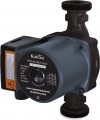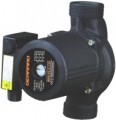Max. flow
The maximum flow of a pump is the amount of liquid it can pump in a certain amount of time.
Features of choosing the optimal performance option depend primarily on the purpose of the pump (see above). For example, for DHW recirculation models, the pump performance should not exceed the performance of the water heater. If the water heater is capable of delivering 10 litres per minute to the DHW circuit, then the maximum pump performance will be 10*60=600 L/h. The basic formula for calculating the performance of a heating system takes into account the power of the heater and the temperature difference at the inlet and outlet, and for the cold water system — the number of points of water intake. More detailed information about the calculations for each application can be found in special sources, and it is better to entrust the calculations themselves to professionals.
Max. operating pressure
The highest pressure in the circuit at which the pump will be able to work normally.
Of course, this parameter cannot be exceeded — the unit may fail due to a breakdown caused by too high pressure (and even if this did not happen right away, it can happen at any time). However, it is worth choosing a model with some margin — so that the pump can normally withstand pressure surges, which are almost inevitable in any pipe.
Max. fluid temperature
The highest liquid temperature that the pump is capable of operating normally.
The possibility of using the unit directly depends on this parameter (see "Suitable for"): for example, models for heating systems must tolerate a temperature of at least 95 °C, and for DHW supply — at least 65 °C. Well, anyway, this parameter should not be exceeded: an overheated pump will fail very quickly, and the consequences of this can be very unpleasant.
Motor type
The type of electric motor provided in the design of the pump.
— Asynchronous. Engines of this type have the simplicity of design and low price, combined with reliability. Their main disadvantage is the dependence of the rotational speed on the load, which leads to the fact that it is difficult to adjust this frequency accurately for such an engine. At the same time, for domestic use, it is not critical and in the professional sphere, it rarely creates difficulties. Therefore, induction motors are very popular in modern pumps.
— Synchronous. Synchronous motors are distinguished by high accuracy in speed control — it practically does not depend on the load on the rotor; this is their main advantage over asynchronous ones. On the other hand, this type is more complex and expensive, and the need for fine adjustment is quite rare. Therefore, synchronous electric motors are mainly installed in high-end pumps designed for use in specific conditions.
Shaft material
It is the material from which the motor shaft in the pump is made.
— Cermet. It is a material that combines metals and their alloys with non-metallic components. In modern pumps, different types of cermets can be used, differing in price and quality; usually, the features in each case directly depend on the price category of the unit. However, it is well suited for household models with relatively low performance but is poorly suitable for professional use. Therefore, in pumps of more than 15,000 litres per hour, cermet shafts are rarely used.
— Stainless steel. This material is highly durable and reliable, due to which it is found in almost all categories of pumps — from relatively simple to professional, the performance of which is in the tens of thousands of litres per hour. However, it is somewhat more expensive than cermets.
Impeller material
It is the material from which the impeller is made. It is the main part of the pump, which provides pressure due to movement.
—
Plastic. This material is inexpensive in itself, and it is easy to process, due to which it is distinguished by low cost. In addition, plastic is not subject to corrosion. On the other hand, it is considered the least reliable of all materials used in modern pumps and, therefore, is used in relatively inexpensive models that are not designed for serious loads. The exception to this rule are special high-strength polymers but they are rare.
—
Stainless steel. As the name suggests, stainless steel is virtually corrosion-resistant. However, this is not its only advantage — this material is very durable and reliable, and due to this, it is used even in powerful high-performance models.
—
Cast iron. This material is in many ways similar to steel — in particular, it is considered very reliable — but it has a slightly higher weight. On the other hand, in most cases, this is not a noticeable drawback, but cast iron costs a little cheaper than stainless steel.
—
Brass. An alloy based on copper and zinc which has a golden colour. The varieties used in circulation pumps are highly resistant to corrosion, they surpass even stainless steel. Therefore, this option is well suited for
...water with a high oxygen content. The disadvantage of brass can be called a rather high cost.Country of brand origin
In this case, the country of origin refers to the country from which the product brand originates. A brand, in turn, is a general designation by which the products of a particular company are known in the market. The country of its origin does not always coincide with the actual place of production of the product: to reduce the cost of production, many modern companies transfer it to other countries. It is quite normal for products, for example, of an American or German brand, to be made in Taiwan or Turkey. Contrary to popular belief, this in itself does not lead to a decrease in the quality of the goods — it all depends on how carefully the brand owner controls the production. And many companies, especially large and famous ones, monitor the quality very zealously — after all, their reputation depends on it.
Protection class
It is an indicator that determines the degree of protection of dangerous (moving and current-carrying) parts of the hardware of the pump from adverse effects, namely solid objects and water. Since pumps, by definition, are used for pumping liquids, and many of them can normally pass quite large particles, in this case, we are talking about protection against moisture and objects from outside.
The level of protection is usually indicated by a marking of the letters IP ("ingress protection") and two numbers, the first of which indicates protection against the effects of solid objects, and the second — against the ingress of water.
For the first digit, each value corresponds to the following protection values: 1 — protection against objects with a diameter of more than 50 mm (large body surfaces) 2 — against objects with a diameter of more than 12.5 mm (fingers, etc.) 3 — against objects more than 2.5 mm (most tools) 4 — against objects larger than 1 mm (virtually all tools, most wires) 5 — dust-proof (total protection against contact; the dust can enter, but does not affect the operation of the device) 6 — dust-proof (case with full dust protection and contact).
For the second digit: 1 — protection against vertically falling drops of water 2 — against drops of water with a deviation of up to 15 ° from the vertical axis of the device 3 — against drops of water with a deviation of up to 60 ° from the vertical axis of the device (rain) 4 — again...st splashes from any direction 5 — from jets from any direction 6 — from sea waves or strong water jets 7 — short-term immersion to a depth of up to 1 m (without the possibility of continuous operation in immersed mode) 8 — long-term immersion to a depth of more than 1 m (with the possibility of permanent operation) in immersed mode).
In some cases, one of the numbers may be replaced by the letter X — this means that the official certification for the corresponding parameter has not been carried out. In pumps, X is usually put in place of the first digit, because a high degree of moisture resistance in itself means a high degree of protection against solid contaminants. At the same time, for such models, an additional letter index can be provided, which describes the degree of protection against specific solid objects — for example, IPX2D. The letter D corresponds to the highest degree of stability, which does not allow the wire to be hit; the previous options A, B and C respectively mean protection from the hand, from the finger and a small tool like a screwdriver.
Insulation class
The heat resistance class of the insulating materials used in the construction of the pump. The higher the heat resistance — the more reliable the device, the less likely it is to ignite or break the insulation in case of overload or overheating. In addition, powerful performant units can become very hot even in normal operations.
In modern pumps, mainly the following classes of insulation are found:
— B. Materials with a heating limit of 130 °C. They are the most modest option by the standards of pumps. Use binding and impregnating compositions of organic origin.
— F. For this class, the heating limit is 155 °C — the average for pumps. Such insulation uses mainly synthetic binders.
— H. Insulating materials based on organosilicon binders/impregnators. Due to this, their heat resistance reaches 180 °C.

